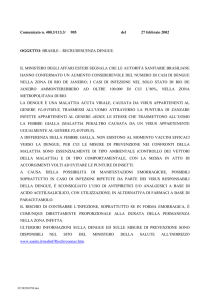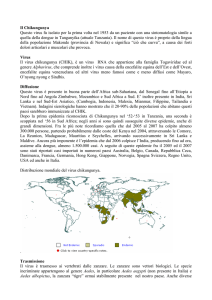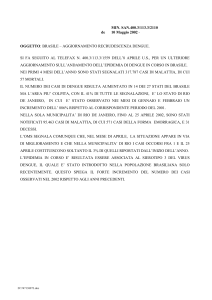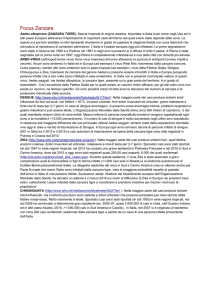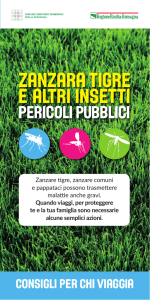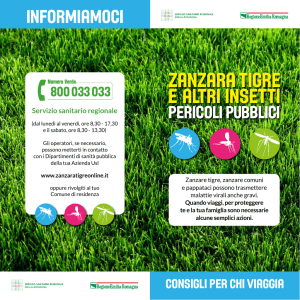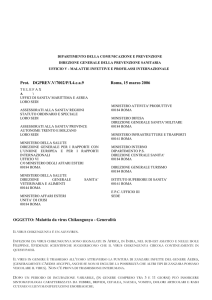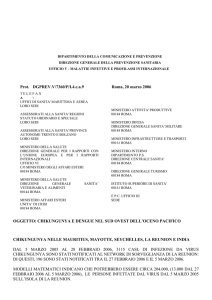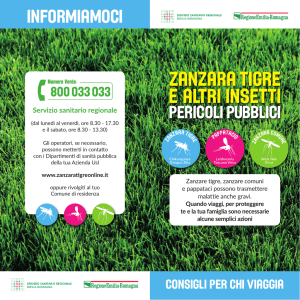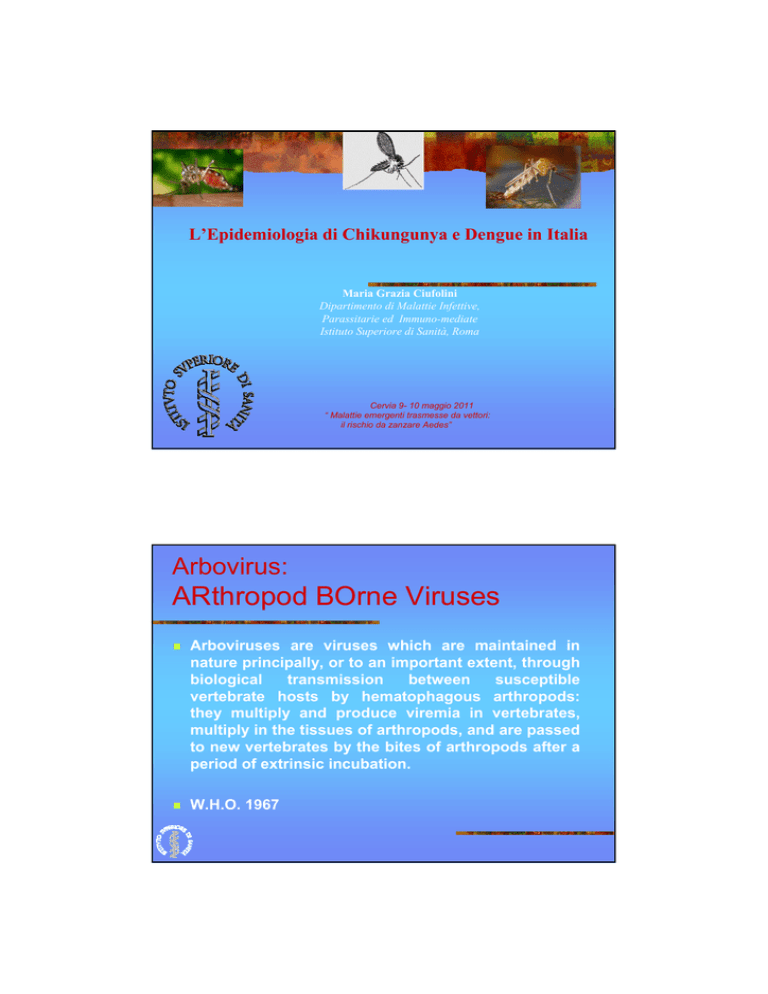
L’Epidemiologia di Chikungunya e Dengue in Italia
Maria Grazia Ciufolini
Dipartimento di Malattie Infettive,
Parassitarie ed Immuno-mediate
Istituto Superiore di Sanità, Roma
Cervia 9- 10 maggio 2011
“ Malattie emergenti trasmesse da vettori:
il rischio da zanzare Aedes”
Arbovirus:
ARthropod BOrne Viruses
Arboviruses are viruses which are maintained in
nature principally, or to an important extent, through
biological
transmission
between
susceptible
vertebrate hosts by hematophagous arthropods:
they multiply and produce viremia in vertebrates,
multiply in the tissues of arthropods, and are passed
to new vertebrates by the bites of arthropods after a
period of extrinsic incubation.
W.H.O. 1967
DENV and CHIKV: epidemiological features
Dengue (DENV) and chikungunya viruses (CHIKV)
are ARthropod BOrne Viruses which share similar
epidemiological features.
Both viruses are endemic in the tropics and are
transmitted to humans through the bite of infected
Aedes mosquitoes.
During recent years, the incidence of both dengue
and chikungunya fever has risen worldwide.
There is no vaccine available for either virus and
prevention relies entirely on mosquito control and
personal protection.
Countries of acquisition and countries of importation of dengue and
chikungunya cases reported by EuroTravNet core sites
in 2008 and the overlapping area of habitation of Aedes albopictus.
Field et al. BMCInfectious Diseases
2010, 10:330
http://www.biomedcentral.com/14712334/10/330
Comparison of the Clinical Features of Chikungunya
Fever and Dengue Fever
J. Erin Staples,et.al Clinical Infectious Diseases 2009; 49:942–8
Dengue: viruses characteristics
Family
Transmission
Flaviviridae:
Flavivirus
Aedes mosquitoes
Viral
Particles
Icosohedral core,
40-60 nm
Structural
Proteins
C, M, E
Genome
Single stranded
positive sense RNA
Dengue
Virus:
Dengue 1
Dengue 2
Dengue 3
Dengue 4
Geographic distribution:
Tropical regions (epidemic during the rainy season)
Public health impact:
High morbidity (estimated 50–100 million annual cases of
DEN and tens-of-thousands of cases of the more severe and
sometimes fatal DHF/DSS syndromes) during epidemics.
Immunity:
There is no cross-protective immunity in humans
Dengue: the viruses
Infection of one of the four DENV serotypes
provides lifelong immunity to that serotype, but
not to the others
Each of the four serotypes can cause a spectrum
of diseases ranging from a clinically inapparent
infection to a potentially lethal disease
Within each DENV serotype different genotypes
has been found on the basis of sequence data
from the E gene
Selected genotypes of virus within serotypes,
have a greater epidemic potential and virulence
Dengue: viral cycles
FOREST
RURAL/SUB-URBAN
Aedes
aegypti
Mosquito
Aedes
Mosquito
Aedes
TOT
TOT
Human
Human
Primati
TOT?
Aedes
aegypti
Mosquito
Aedes
Mosquito
Aedes
AFRICA
Aedes (Diceromya)
Aedes (Stegomyia)
URBAN
Ae. albopictus
Ae. polynesiensis
Ae. aegypti
Ae. albopictus
Ae. aegypti
Ae. mediovittatus
Ae. polynesiensis
ASIA
Aedes (Finlaya)
Aedes (Stegomyia)
AMERICA
Aedes spp.
Aedes spp.
Dengue: replication and
transmission of virus
1.
The virus is transmitted to
man through the saliva of
mosquitoes
2.
The virus replicates
in target organs
n
o
3.
4.
The virus infects
the limphocytes
and lymphocit
tissues
The virus is released
into the blood
circulation
q
p
Dengue: replication and
transmission of virus (2)
5. A second mosquito
ingests the virus from
the blood
6. The virus replicates in
the intestine and later
reaches the saliva
glands
s
t
r
7. The virus replicates in the
saliva glands
Dengue fever (DF): clinical
characteristics
Incubation period: 3-14 days,
usually 4-7 days
High Fever
Headaches
Muscular pains and articulation problems
Nausea / vomiting
Esanthema
Hemorrhagic manifestations
Dengue haemorrhagic fever
DHF
DHF I
Fever, trombocitopenia , haemoconcentration
Positive “Tourniquet” test and or easy bruising.
DHF II
All DHF I criteria + spontaneous bleeding
DHF III
All DHF I /II criteria + one of the following :
1. Rapid/weak pulse and narrow pulse pressure
2. Hypotension with cold , clammy skin and restlessness
DHF IV
All DHF I /II criteria +undetectable blood pressure or pulse
DHF/DSS: risk factors
Strain of virus
Previous infection with
heterotypic DENV
Age
Genetic background of the
person
Dengue is seldom recognized as an important disease in Europe. DF has
been diagnosed in increasing proportions of febrile travellers returning
from the tropics, ranging from 2% in the early 1990s to 16% more
recently. Due to the non-specific and self-limiting nature of milder
infections, these figures are likely to be an underestimation caused by
underreporting.
Diagnosis of imported diseases
Samples
Serum (20°C) to be provided with notices about morbidity and epidemiologic data about the patients
Positive:
•RT-PCR positive
•Serologic tests
(seroconversion,
IgM positivity, four-fold
rise of antibody titer)
Past infections:
•RT-PCR negative
•IgG positive
•IgM negative
Indetermined:
just one serum
sample and
negative RTPCR and
negligible titer
Negative:
•RT-PCR
negative
•Negative
serologic
results
Casi importati di Dengue in Italia
CHIK
120
100
80
60
40
20
0
Positive
1990 1991 1992 1993 1994 1995 1996 1997 1998 1999 2000 2001 2002 2003 2004 2005 2006 2007 2008 2009 2010
Pregressed
Undetermined
Negative
Casi importati di Dengue in Italia
CHIK
120
100
80
60
40
20
0
Positive
1990 1991 1992 1993 1994 1995 1996 1997 1998 1999 2000 2001 2002 2003 2004 2005 2006 2007 2008 2009 2010
Pregressed
Undetermined
Dengue importata: distribuzione
regionale
Negative
Dengue Importata: origine
geografica
Virus CHIK
Famiglia
Togaviridae
Genere
Alphavirus
Trasmissione:
zanzare Aedes
Virus a RNA a
singolo filamento,
con envelope.
Chikungunya
•Alphavirus genus (Togaviridae
(Togaviridae family)
•Identified in the Newala District, Tanzania, in
1952
•Transmitted by Aedes spp mosquitoes
•Endemic in several areas of Africa
•Recurrent epidemics in Asia
Life cycle of Chikungunya virus in Africa showing the interconnection
between the sylvatic cycle on the left and the urban
cycle on the right
Michelle M. Thiboutotet al, April 2010
CHIK: la distribuzione nell’Oceano
Indiano (2006)
India: >1.000.000 di casi sospetti
Comore: >5.000 casi sospetti nel 2005
Malesia: 20.000 casi sospetti
Seychelles: >8.800 casi sospetti
Mauritius: 6.000 casi sospetti
Mayotte: 6.000 casi sospetti
Madagascar: numerosi casi sospetti
La Réunion: 266.000 casi sospetti dal 2005
Lancet, 1 dicembre 2007
Ravenna Epidemic
21 June : A healthy man from Kerala, India, arrives at
the Milan airport. He goes to his home at Forlimpopoli.
23 June : He goes to visit his cousin, living in Castiglione
di Cervia. That evening he develops a high fever.
4 July: The cousin also develops a high fever, with pains
in joints and a rash. In the next few days the whole
family falls sick.
The illness spreads to Castiglione di Cervia and
Castiglione di Ravenna.
In the second half of August the epidemic reaches a
peak.
Epidemic Curve by Presumed
Place of Infection
12
11
10
9
Other location
Cervia
Castiglione di Cervia and
Castiglione di Ravenna
8
No. of cases
7
6
5
4
3
2
1
0
23-Jun
30-Jun
7-Jul
14-Jul
21-Jul
28-Jul
4-Aug
11-Aug
18-Aug
25-Aug
1-Sep
8-Sep
15-Sep
•The 2005-2006 outbreak in the Indian Ocean
was associated with a CHIKV strain with a
mutation in the envelope protein gene (E1A226V)
•This single amino acid substitution appeared
to influence vector specificity increasing
CHIKV fitness in Aedes albopictus
Vazeille M, PLOS One, Nov 2007
Konstantin A, PLOS Pathogens, Dec 2007
Phylogenetic analysis of the partial nucleotide sequence (1011
nucleotides)
nucleotides) of the E1 gene of CHIKV strains identified in Italy and in
different parts of the world
CHIKs/
CHIKs/Ravenna.ITA/34
Ravenna.ITA/34--07/1
CHIKs/
CHIKs/Ravenna.ITA/34
Ravenna.ITA/34--07/3
CHIKs/
CHIKs/Ravenna.ITA/34
Ravenna.ITA/34--07/2
CHIKs/
CHIKs/Ravenna.ITA/34
Ravenna.ITA/34--07/6
CHIKs/
CHIKs/Ravenna.ITA/34
Ravenna.ITA/34--07/4
CHIKs/
CHIKs/Ravenna.ITA/34
Ravenna.ITA/34--07/7
INDIND-0606-RJ1
Central/East
Central/East African genotype
INDIND-0606-TN1
INDIND-0606-AP3
100
INDIND-0606-MH2
INDIND-0606-KA15
85
Mauritius D570/06
LR2006 OPY1OPY1-Reunion
INDIND-0000-MH4
Tanzania-S27. ECSA
96 TanzaniaTanzaniaTanzania-strain Ross
IND-6363-WB1 (Kolkata) Asian
100 IND-
Asian genotype
INDIND-7373-MH5 (Barsi
(Barsi)) Asian
100
Nigeria 64 WA
Senegal -83 WA 37997
0.005
West African genotype
CHIK: le epidemie
Tilston, Skelly and Weinstein,, 2009
Imported cases of CHIK in Italy
120
N° of cases
100
80
60
40
20
0
2006
2007
Positive
2008
Negative
2009
2010
CHIK importata: provenienza delle
richieste di diagnosi
CHIK importata: origine geografica
Conclusions
•Recurrence of Chikungunya and introduction of
other viruses (Dengue?) cannot be excluded
• Sustainment of the epidemics beyond the warm
season is unlikely in absence of dramatic climate
change, (due to lack of transovarial transmission)
•Improvement of diagnostic capacity and
effective surveillance and control of exotic
vectorborne infections is needed in preparedness
plans in the EU
Many thanks to
Loredana Nicoletti
Antonella Marchi
Cristiano Fiorentini
Fabio Magurano
Claudia Fortuna
Eleonora Benedetti
Paola Bucci
Maria Elena Remoli
Melissa Baggieri
Giovanni Rezza
Thank you for your attention

